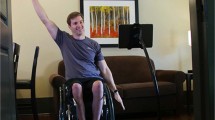Abstract
Eight women with severe multiple disabilities were provided with simple mechanical switches that when depressed, activated battery-operated leisure items. Switches were provided for 1 hr during recreation when participants were sitting in wheelchairs and for 2 hr during therapeutic positioning when participants were lying on their beds or on wedges. No instructions or physical prompts were used to teach or maintain depression of the switch. Duration of switch depression in each session was recorded in 2 experimental conditions: (a) sessions when switch depression produced immediate activation of the leisure device and (b) sessions when switch depression produced no activation. Seven of eight participants showed higher rates of switch depression during conditions of immediate activation of the leisure device than in no-activation conditions. Seven of eight participants also showed similar rates of switch depression across conditions in both sitting and nonsitting positions.
Similar content being viewed by others
REFERENCES
Baer, D., Wolf, M., and Risley, T. R. (1968). Some current dimensions of applied behavior analysis. J. Appl. Behav. Analys. 1: 91–97.
Ball, T. S., Combs, T., Rugh, J., and Neptune, R. (1977). Automated range of motion training with two cerebral palsied retarded young men. Ment. Retard. 15: 47–50.
Crouse, J., and Deavours, M. N. (1993). Switch technology in therapeutic recreation programming: An idea whose time has come. Palaestra: 41–44.
Dattilo, J., and Mirenda, P. (1987). An application of a leisure preference assessment protocol for persons with severe handicaps. J. Assoc. Pers. Severe Handicap. 12: 306–311.
Leatherby, J. G., Gast, D. L., Wolery, M., and Collins, B. C. (1992). Assessment of reinforcer preference in multi-handicapped students. J. Dev. Disab. 4: 15–36.
May, D. C. (1983). The use of an electric switch to increase independent head control in a severely handicapped student. J. Spec. Educ. Technol. 4: 14–19.
Mental retardation: Definition, Classification, and Systems of Support, 9th Ed, 1992, American Association on Mental Retardation, Washington, DC.
Realon, R., Favell, J. E., and Dayvault, K. A. (1988). Evaluating the use of adapted leisure materials on the engagement of persons who are profoundly, multiply handicapped. Educ. Train. Men. Retard. 23: 228–237.
Wacker, D. P., Berg, W. K., Wiggins, M. M., and Cavanaugh, J. (1985). Evaluation of reinforcer preferences for profoundly handicapped students. J. Appl. Behav. Analys. 18: 173–178.
Author information
Authors and Affiliations
Rights and permissions
About this article
Cite this article
Saunders, M.D., Questad, K.A., Kedziorski, T.L. et al. Unprompted Mechanical Switch Use in Individuals with Severe Multiple Disabilities: An Evaluation of the Effects of Body Position. Journal of Developmental and Physical Disabilities 13, 27–39 (2001). https://doi.org/10.1023/A:1026505332347
Issue Date:
DOI: https://doi.org/10.1023/A:1026505332347




